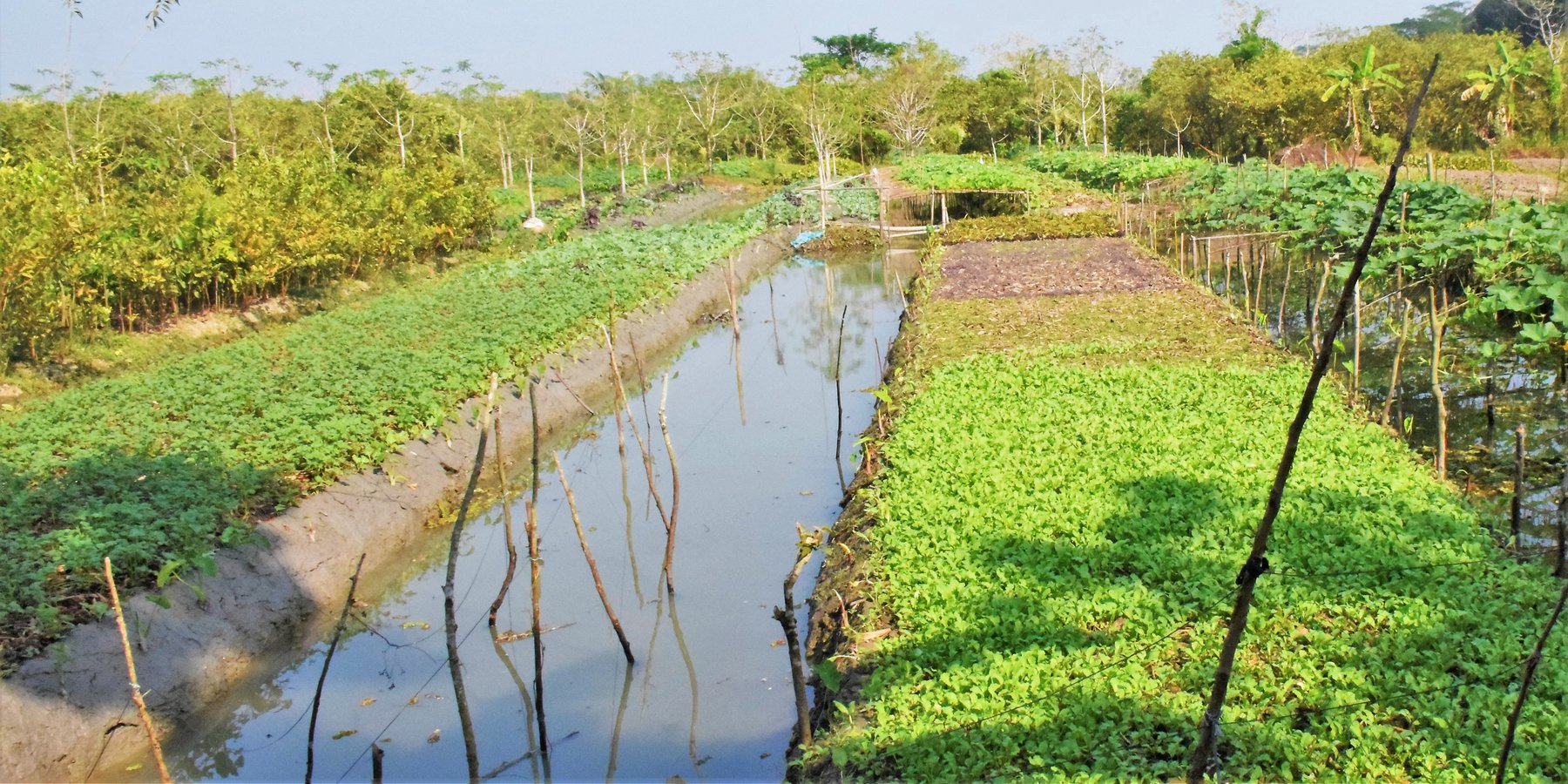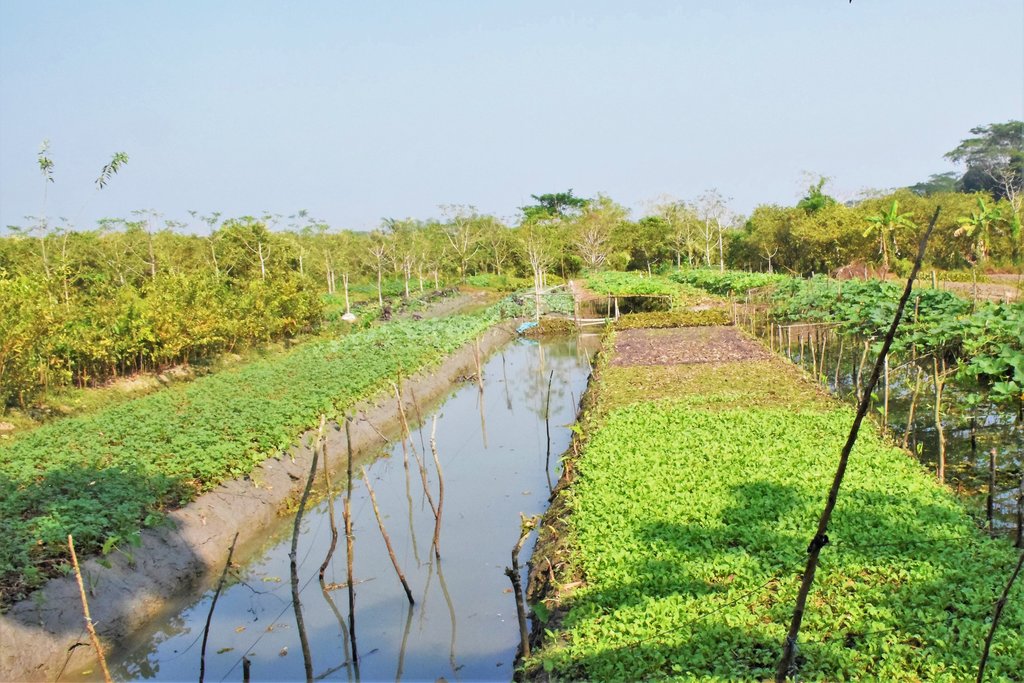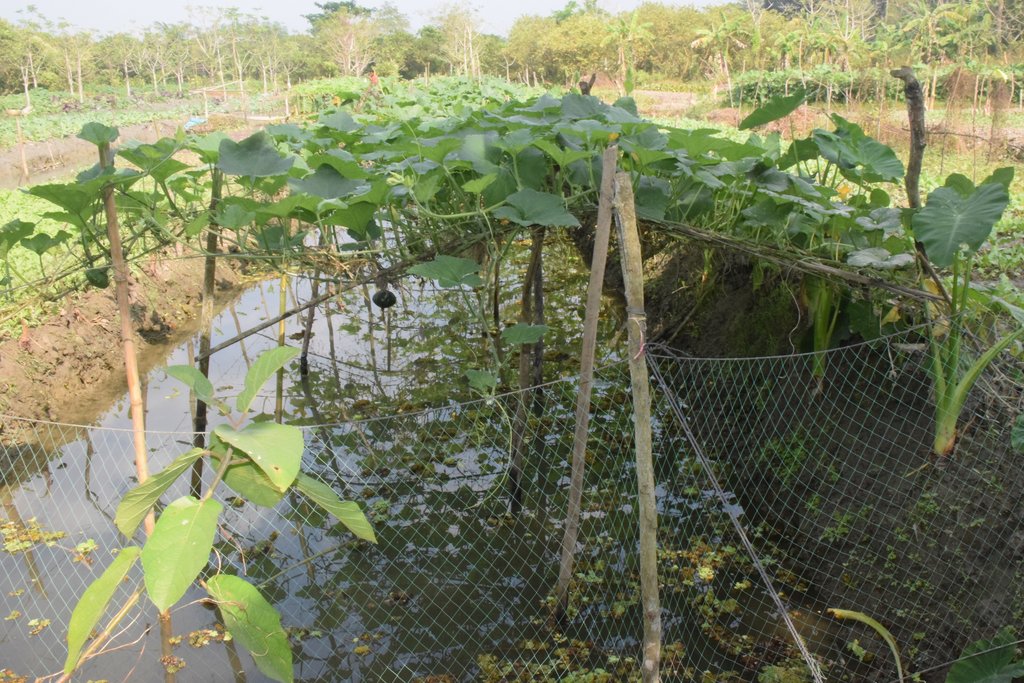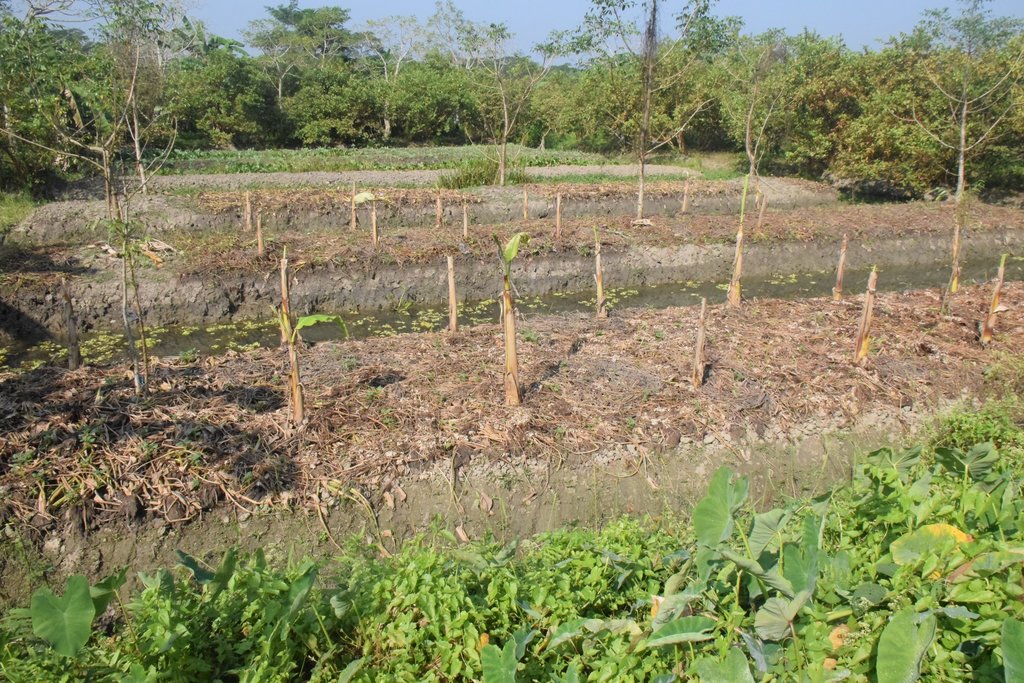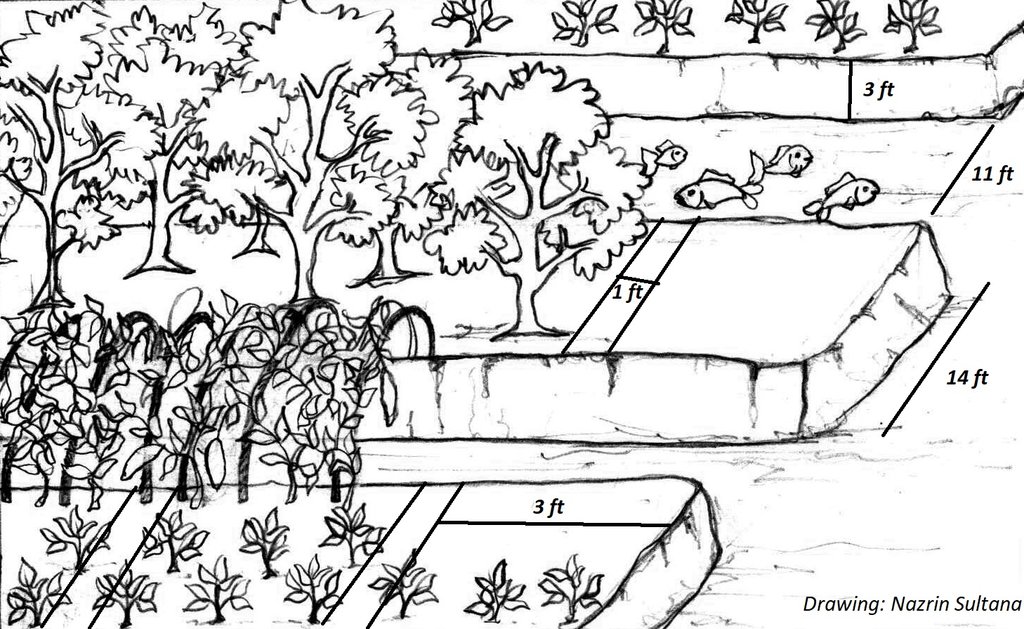Dyke and Ditch multi-cropping system [Bangladesh]
- Creation:
- Update:
- Compiler: Fazlay Arafat
- Editor: –
- Reviewers: Nicole Harari, Rima Mekdaschi Studer, Ursula Gaemperli
Kandhi-Berh chas poddhoti
technologies_4227 - Bangladesh
View sections
Expand all Collapse all1. General information
1.2 Contact details of resource persons and institutions involved in the assessment and documentation of the Technology
Key resource person(s)
land user:
Howlader Abdus Sattar
Bangladesh
land user:
Howlader Najrul Islam
Bangladesh
land user:
Faruk Omaor
Bangladesh
Name of project which facilitated the documentation/ evaluation of the Technology (if relevant)
Decision Support for Mainstreaming and Scaling out Sustainable Land Management (GEF-FAO / DS-SLM)Name of the institution(s) which facilitated the documentation/ evaluation of the Technology (if relevant)
Bangladesh Forest Department (Bangladesh Forest Department) - BangladeshName of the institution(s) which facilitated the documentation/ evaluation of the Technology (if relevant)
Soil Resource Development Institute (SRDI) (Soil Resource Development Institute (SRDI)) - BangladeshName of the institution(s) which facilitated the documentation/ evaluation of the Technology (if relevant)
Department of Agricultural Extension (DAE) - Bangladesh1.3 Conditions regarding the use of data documented through WOCAT
The compiler and key resource person(s) accept the conditions regarding the use of data documented through WOCAT:
Yes
1.4 Declaration on sustainability of the described Technology
Is the Technology described here problematic with regard to land degradation, so that it cannot be declared a sustainable land management technology?
No
2. Description of the SLM Technology
2.1 Short description of the Technology
Definition of the Technology:
Landform changes to dyke and ditch to introduce multiple crops.
2.2 Detailed description of the Technology
Description:
Marshy land covers most of the area of southern Bangladesh in the estuaries of the big rivers, including Swarupkathi Upazila. This area typically floods for more than 9 months, is perennially wet, and is covered by Hogla (Typha), Reed plant, and weeds. Crop cultivation has been difficult due to unfavourable drainage conditions. Local people previously cultivated paddy only in small areas by clearing the swamp vegetation. Now, however, some of the marshy land has been converted to a dyke and ditch multi-cropping system, which has been practiced for the last 200 years. Through this practice, the marshlands have provided valuable harvests for generations and currently yield vegetables, fruits, timber and fishes for farmers and that support local livelihoods. The marshland ecosystem, that converted to terrestrial ecosystem now support habitat for a wide range of flora and fauna. The technology reduces the pressure on arable land through construction of dykes which also plays a crucial role in flood mitigation. The continuous series of dykes and ditches with diverse vegetation increases the aesthetic beauty of the region and conserve biodiversity as well.
The dykes are elevated beds of soil constructed to 4-6 feet height and 12-14 feet width. The dykes are constructed with soils collected from ditches and on the top of the bed water hyacinth composed are used. Along with increasing fertility, water hyacinth compost also increases the soil holding capacity of the dykes. Though water hyacinth is normally one of the most dangerous invasive species, it can be converted to useful resource by this system. The ditches are 10-11 feet wide canals and deep enough for fish culture. According to size of land owned by farmer the length of each dyke and ditch varies. All the ditches are interconnected with a regular flow of water. Once the dyke preparation is complete, crops including brinjal (eggplant), turnip, red amaranth, coriander, spinach, cowpea, chili, cornflower, tomato, papaya are planted. On the bed, 1 foot wide drain is constructed after every 3 feet intervals. Creepers and vines are planted on sticks along the sides of the dyke to prevent erosion. Trellis crops like bottle gourd, bitter gourd, ash gourd, sweet gourd, cucumber, etc. are cultivated in between two dykes and over the ditches. Guava, Hog plum, banana, lemon, pineapples and other fruit trees planted are in the bed after three years of establishment. Timber trees are also introduced in the dykes over time though some beds are only managed for crop cultivation. Through this way, they establish a multi-crop and agro-forestry system. In the ditches, farmers cultivate local fish varieties that generate extra income for them. Water hyacinth also managed in the ditch that used as fertilizer in the bed. Farmer add soil to the dyke from the ditches once in every year to raise the dyke and make it stable. The local community also developed a large floating market of guava, which now attracts tourism in this area and facilitates alternate income.
The initial investment of establishing dyke and ditch technology is expensive due to huge labour requirement for dyke preparation and often difficult for farmers to manage the required money. Usually they take loans from neighbours or micro credit organizations with high interest to initiate the work. Almost 80% of the households are involved with micro credits in Swarupkathi because loans from the national bank is much more time-consuming. If the farmers can get easier access to loan and marketing facilities from the government, they will benefit more from the dyke and ditch system.
2.3 Photos of the Technology
General remarks regarding photos:
These are the photos of 1st year of dyke and ditch cropping system; vegetables will be replaced eventually by Guava/Hog Plum etc.
2.5 Country/ region/ locations where the Technology has been applied and which are covered by this assessment
Country:
Bangladesh
Region/ State/ Province:
Barishal Division
Further specification of location:
Atghor Kuriana, Swarupkathi, Pirojpur
Specify the spread of the Technology:
- evenly spread over an area
If precise area is not known, indicate approximate area covered:
- 100-1,000 km2
Is/are the technology site(s) located in a permanently protected area?
No
Map
×2.6 Date of implementation
If precise year is not known, indicate approximate date:
- more than 50 years ago (traditional)
2.7 Introduction of the Technology
Specify how the Technology was introduced:
- as part of a traditional system (> 50 years)
Comments (type of project, etc.):
This practice spread out through local community.
3. Classification of the SLM Technology
3.1 Main purpose(s) of the Technology
- improve production
- reduce, prevent, restore land degradation
- reduce risk of disasters
- create beneficial economic impact
3.2 Current land use type(s) where the Technology is applied
Land use mixed within the same land unit:
Yes
Specify mixed land use (crops/ grazing/ trees):
- Agroforestry

Cropland
- Annual cropping
- Perennial (non-woody) cropping
- Tree and shrub cropping
Annual cropping - Specify crops:
- root/tuber crops - potatoes
- vegetables - leafy vegetables (salads, cabbage, spinach, other)
- vegetables - melon, pumpkin, squash or gourd
Perennial (non-woody) cropping - Specify crops:
- banana/plantain/abaca
- pineapple
- sugar cane
Tree and shrub cropping - Specify crops:
- fruits, other
- mango, mangosteen, guava
- papaya
Number of growing seasons per year:
- 3
Is intercropping practiced?
Yes
If yes, specify which crops are intercropped:
Radish, Cabbage, Cauliflower, Chili, Indian Spinach, Red amaranth, Coriander, Potato, Taro, Bottle gourd, Sweet gourd, Brinjal, Yard long bean, Bitter gourd etc. mixed with Sugarcane, Guava, Hog plum, Coconut, Betel nut. In the ditches between the horticultural dykes, some farmers also practice fish farming with local fish verities.
Is crop rotation practiced?
No
Comments:
As closest cropping system agroforestry is selected. The crop composition is seasonal vegetables followed by horticulture crops.
3.3 Has land use changed due to the implementation of the Technology?
Has land use changed due to the implementation of the Technology?
- Yes (Please fill out the questions below with regard to the land use before implementation of the Technology)
Land use mixed within the same land unit:
No

Cropland
- Annual cropping
Annual cropping - Specify crops:
- cereals - rice (wetland)
Is intercropping practiced?
No
Is crop rotation practiced?
No
3.4 Water supply
Water supply for the land on which the Technology is applied:
- mixed rainfed-irrigated
Comments:
Manual irrigation practiced as supplementary.
3.5 SLM group to which the Technology belongs
- agroforestry
- integrated soil fertility management
- wetland protection/ management
- Agri-horticulture
3.6 SLM measures comprising the Technology

agronomic measures
- A2: Organic matter/ soil fertility

structural measures
- S11: Others

management measures
- M1: Change of land use type
Comments:
Ditch and dyke establishment to avoid prolonged water logging situation.
3.7 Main types of land degradation addressed by the Technology

water degradation
- Hs: change in quantity of surface water
Comments:
Prolonged water logging was the problem of this area. Through establishment of ditch and dyke system the community overcome the situation and is now growing their crops year round.
3.8 Prevention, reduction, or restoration of land degradation
Specify the goal of the Technology with regard to land degradation:
- reduce land degradation
Comments:
Through dyke and ditch method, crop production was increased tough total cropping area was decreased due to preparation of ditch
4. Technical specifications, implementation activities, inputs, and costs
4.1 Technical drawing of the Technology
Technical specifications (related to technical drawing):
Width of dyke: 12-14 ft, (3.6m-4m)
Height of dyke: 3-4 ft from water surface (1-1.2m)
Width of ditch: 10-11 ft (3-3.4m)
Width of drain in bed: 1 ft (30cm)
Interval of drain in bed: 3 ft (1m)
Author:
Nazrin Sultana
Date:
17/04/2019
4.2 General information regarding the calculation of inputs and costs
Specify how costs and inputs were calculated:
- per Technology area
Indicate size and area unit:
1 acre
other/ national currency (specify):
BDT
If relevant, indicate exchange rate from USD to local currency (e.g. 1 USD = 79.9 Brazilian Real): 1 USD =:
84.0
Indicate average wage cost of hired labour per day:
BDT 500
4.3 Establishment activities
| Activity | Timing (season) | |
|---|---|---|
| 1. | Earth work (dyke preparation, bed leveling with water hyacinth compost, drain preparation on bed) | December to February |
| 2. | Seasonal/annual planting of crops and vegetables | Seasonal |
| 3. | Planting of horticultural tree and shrub species after 2-3 years of crop cultivation | Jun-July |
4.4 Costs and inputs needed for establishment
| Specify input | Unit | Quantity | Costs per Unit | Total costs per input | % of costs borne by land users | |
|---|---|---|---|---|---|---|
| Labour | Earth work (dyke preparation, bed leveling with water hyacinth compost, drain preparation on bed) | person-days | 200.0 | 500.0 | 100000.0 | 100.0 |
| Labour | Cultivation | person-day | 100.0 | 500.0 | 50000.0 | 100.0 |
| Labour | Weeding | person-day | 60.0 | 500.0 | 30000.0 | 100.0 |
| Equipment | Spade | pieces | 2.0 | 250.0 | 500.0 | 100.0 |
| Equipment | Weeder (manual weeding tool) | pieces | 2.0 | 150.0 | 300.0 | 100.0 |
| Equipment | Bucket | pieces | 2.0 | 150.0 | 300.0 | 100.0 |
| Equipment | Net (to support trellis crops cultivation in between dykes)) | kg | 20.0 | 60.0 | 1200.0 | 100.0 |
| Equipment | Bamboo sticks (to support the nets and creepers vegetable) | pieces | 200.0 | 2.0 | 400.0 | 100.0 |
| Plant material | Seeds (needed over first 2-3 years of establishment) | kg | 0.5 | 2000.0 | 1000.0 | 100.0 |
| Plant material | Seedling (needed over first 2-3 years of establishment) | pieces | 300.0 | 20.0 | 6000.0 | 100.0 |
| Fertilizers and biocides | T.S.P | kg | 66.0 | 22.0 | 1452.0 | 100.0 |
| Fertilizers and biocides | Urea | kg | 66.0 | 16.0 | 1056.0 | 100.0 |
| Fertilizers and biocides | MoP | kg | 22.0 | 15.0 | 330.0 | 100.0 |
| Fertilizers and biocides | Pesticides | litre | 1.0 | 5000.0 | 5000.0 | 100.0 |
| Total costs for establishment of the Technology | 197538.0 | |||||
| Total costs for establishment of the Technology in USD | 2351.64 | |||||
Comments:
Earth work is the prime establishment cost of this technology and others are the regular cropping cost
4.5 Maintenance/ recurrent activities
| Activity | Timing/ frequency | |
|---|---|---|
| 1. | Dyke management (add soil and water hyacinth to the dyke, bed leveling, drainage system on bed) | March-April |
4.6 Costs and inputs needed for maintenance/ recurrent activities (per year)
| Specify input | Unit | Quantity | Costs per Unit | Total costs per input | % of costs borne by land users | |
|---|---|---|---|---|---|---|
| Labour | Dyke management (add soil and water hyacinth to the dyke, bed leveling, drainage system on bed) | person-days | 66.0 | 500.0 | 33000.0 | 100.0 |
| Equipment | Spade | pieces | 2.0 | 250.0 | 500.0 | 100.0 |
| Equipment | Bucket | pieces | 2.0 | 150.0 | 300.0 | 100.0 |
| Total costs for maintenance of the Technology | 33800.0 | |||||
| Total costs for maintenance of the Technology in USD | 402.38 | |||||
4.7 Most important factors affecting the costs
Describe the most determinate factors affecting the costs:
Labor cost
5. Natural and human environment
5.1 Climate
Annual rainfall
- < 250 mm
- 251-500 mm
- 501-750 mm
- 751-1,000 mm
- 1,001-1,500 mm
- 1,501-2,000 mm
- 2,001-3,000 mm
- 3,001-4,000 mm
- > 4,000 mm
Specify average annual rainfall (if known), in mm:
2184.00
Agro-climatic zone
- sub-humid
5.2 Topography
Slopes on average:
- flat (0-2%)
- gentle (3-5%)
- moderate (6-10%)
- rolling (11-15%)
- hilly (16-30%)
- steep (31-60%)
- very steep (>60%)
Landforms:
- plateau/plains
- ridges
- mountain slopes
- hill slopes
- footslopes
- valley floors
Altitudinal zone:
- 0-100 m a.s.l.
- 101-500 m a.s.l.
- 501-1,000 m a.s.l.
- 1,001-1,500 m a.s.l.
- 1,501-2,000 m a.s.l.
- 2,001-2,500 m a.s.l.
- 2,501-3,000 m a.s.l.
- 3,001-4,000 m a.s.l.
- > 4,000 m a.s.l.
Indicate if the Technology is specifically applied in:
- not relevant
5.3 Soils
Soil depth on average:
- very shallow (0-20 cm)
- shallow (21-50 cm)
- moderately deep (51-80 cm)
- deep (81-120 cm)
- very deep (> 120 cm)
Soil texture (topsoil):
- fine/ heavy (clay)
Soil texture (> 20 cm below surface):
- fine/ heavy (clay)
Topsoil organic matter:
- medium (1-3%)
5.4 Water availability and quality
Ground water table:
< 5 m
Availability of surface water:
good
Water quality (untreated):
for agricultural use only (irrigation)
Water quality refers to:
surface water
Is water salinity a problem?
No
Is flooding of the area occurring?
Yes
Regularity:
episodically
5.5 Biodiversity
Species diversity:
- medium
Habitat diversity:
- medium
5.6 Characteristics of land users applying the Technology
Sedentary or nomadic:
- Sedentary
Market orientation of production system:
- mixed (subsistence/ commercial)
Off-farm income:
- 10-50% of all income
Relative level of wealth:
- poor
Individuals or groups:
- individual/ household
Level of mechanization:
- manual work
Gender:
- women
- men
Age of land users:
- middle-aged
5.7 Average area of land used by land users applying the Technology
- < 0.5 ha
- 0.5-1 ha
- 1-2 ha
- 2-5 ha
- 5-15 ha
- 15-50 ha
- 50-100 ha
- 100-500 ha
- 500-1,000 ha
- 1,000-10,000 ha
- > 10,000 ha
Is this considered small-, medium- or large-scale (referring to local context)?
- small-scale
- medium-scale
5.8 Land ownership, land use rights, and water use rights
Land ownership:
- individual, not titled
- individual, titled
Land use rights:
- leased
- individual
Water use rights:
- open access (unorganized)
Are land use rights based on a traditional legal system?
Yes
Specify:
Law of inheritance
5.9 Access to services and infrastructure
health:
- poor
- moderate
- good
education:
- poor
- moderate
- good
technical assistance:
- poor
- moderate
- good
employment (e.g. off-farm):
- poor
- moderate
- good
markets:
- poor
- moderate
- good
energy:
- poor
- moderate
- good
roads and transport:
- poor
- moderate
- good
drinking water and sanitation:
- poor
- moderate
- good
financial services:
- poor
- moderate
- good
6. Impacts and concluding statements
6.1 On-site impacts the Technology has shown
Socio-economic impacts
Production
crop production
crop quality
risk of production failure
product diversity
production area
land management
Income and costs
expenses on agricultural inputs
farm income
diversity of income sources
economic disparities
Comments/ specify:
economic disparities decreased as marginal and landless farmers get the opportunity to grow crops on dykes and fish in ditches
workload
Socio-cultural impacts
food security/ self-sufficiency
health situation
Comments/ specify:
through ditch and dyke cultivation technique local community get access to vegetable and fish source
cultural opportunities
recreational opportunities
community institutions
Comments/ specify:
local farmers are now forming groups and working together to transport their crops to market
SLM/ land degradation knowledge
situation of socially and economically disadvantaged groups
Comments/ specify:
landless farmers get opportunity to work as paid labor
Ecological impacts
Water cycle/ runoff
evaporation
Comments/ specify:
evaporation decreased due to the presence of vegetation in dykes
Soil
soil moisture
Comments/ specify:
Soil moisture decreased in dykes and before it was too swampy for agricultural activities
soil cover
soil loss
soil accumulation
nutrient cycling/ recharge
soil organic matter/ below ground C
Biodiversity: vegetation, animals
Vegetation cover
biomass/ above ground C
plant diversity
beneficial species
habitat diversity
pest/ disease control
Climate and disaster risk reduction
flood impacts
emission of carbon and greenhouse gases
wind velocity
micro-climate
6.2 Off-site impacts the Technology has shown
impact of greenhouse gases
6.3 Exposure and sensitivity of the Technology to gradual climate change and climate-related extremes/ disasters (as perceived by land users)
Gradual climate change
Gradual climate change
| Season | increase or decrease | How does the Technology cope with it? | |
|---|---|---|---|
| annual temperature | increase | well | |
| seasonal temperature | summer | increase | well |
| annual rainfall | decrease | well | |
| seasonal rainfall | wet/ rainy season | decrease | well |
Climate-related extremes (disasters)
Meteorological disasters
| How does the Technology cope with it? | |
|---|---|
| tropical storm | well |
Hydrological disasters
| How does the Technology cope with it? | |
|---|---|
| general (river) flood | very well |
6.4 Cost-benefit analysis
How do the benefits compare with the establishment costs (from land users’ perspective)?
Short-term returns:
slightly positive
Long-term returns:
very positive
How do the benefits compare with the maintenance/ recurrent costs (from land users' perspective)?
Short-term returns:
positive
Long-term returns:
very positive
6.5 Adoption of the Technology
- > 50%
Of all those who have adopted the Technology, how many did so spontaneously, i.e. without receiving any material incentives/ payments?
- 91-100%
6.6 Adaptation
Has the Technology been modified recently to adapt to changing conditions?
No
6.7 Strengths/ advantages/ opportunities of the Technology
| Strengths/ advantages/ opportunities in the land user’s view |
|---|
| 1. Introduction of multi crops. |
| 2. Maintaining daily households nutrition needs. |
| 3. Support natural fish catching. |
| 4. Improve economic condition of local communities. |
| 5. Reduce risk of crop failure. |
| 6. Improved access to health and education. |
| Strengths/ advantages/ opportunities in the compiler’s or other key resource person’s view |
|---|
| Socio-economic condition improved |
| Improved soil nutrient balance |
| Increase crop intensity and diversity |
| Reduce green house gas emission |
| Improved biodiversity |
6.8 Weaknesses/ disadvantages/ risks of the Technology and ways of overcoming them
| Weaknesses/ disadvantages/ risks in the land user’s view | How can they be overcome? |
|---|---|
| Establishment cost is high | Easy loan facilities by government |
| Unavailability of labor | Standard payment for labor |
| Lack of post harvest processing/storage facility | Government initiatives to establish processing and store house |
| Late harvesting of crops and eventually low price for sale | Use high yielding and early crop varieties |
| Weaknesses/ disadvantages/ risks in the compiler’s or other key resource person’s view | How can they be overcome? |
|---|---|
| Absence of perfect market | Through government initiative facilitate a market place |
| Grazing hampers the stand at the initial stage | Community awareness |
7. References and links
7.1 Methods/ sources of information
- field visits, field surveys
Number of informants: 12
- interviews with land users
Number of informants: 10
- interviews with SLM specialists/ experts
Number of informants: 02
When were the data compiled (in the field)?
25/11/2018
7.2 References to available publications
Title, author, year, ISBN:
Rahman, M. (2014). Framing Ecosystem-based Adaptation to Climate Change: Applicability in the Coast of Bangladesh, Dhaka, Bangladesh: IUCN, x+43pp.
Available from where? Costs?
Mangrove for Future, Bangladesh.
7.3 Links to relevant online information
Title/ description:
Ditch-and-dyke schemes for year-round cultivation
URL:
www.mangrovesforthefuture.org/assets/Repository/Documents/Framing-ecosystem-based-adaptation-BangladeshcIUCN2014.pdf
7.4 General comments
The WOCAT questionnaire covers all the technical aspect of this practice.
Links and modules
Expand all Collapse allLinks
No links
Modules
No modules


